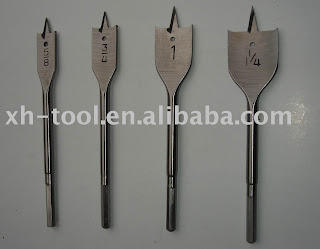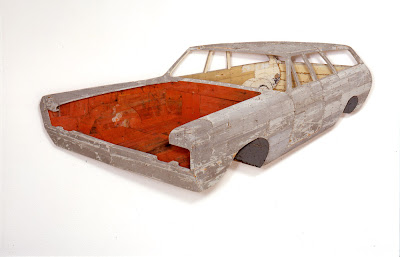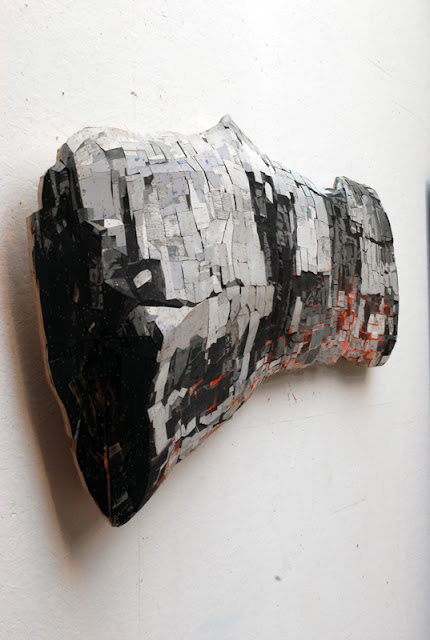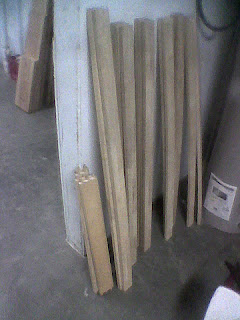North Carolina's Bob Trotman is June's featured artist. Post questions for him in the comments of this post.
I have done a lot of repair and some festival-going in the last week and a half. A few beautiful mashup things were sold quickly and I don't have pictures. One was an 80's shaped hardwood desk base that I matched up with a vintage sheet of bird's eye maple veneer plywood for the top. The bottom layer of the bird's eye looked like weathered leather but it may have been a severely distressed finish applied very thick? About 40x22, 7-layer finish ply with a drawer pull (type of thing) cut out along one edge - the most unique piece of scrap I've run into in a long time!
On this Formica table, I painted the legs burgundy.
Then I built Icehouse II bookcase on commission:
Starting with the door (backing), I cut of the bottom to make it even and to clean off a thin layer of woodrot in the endgrain. The worn, graffitied door was beaten apart from the sides of the tool cabinet it once enclosed, so splintered edges were split off with a chisel. I then wire brushed away the loose paint chips and triple-coated it with water-based polyurethane front and back.(4 layers on exposed endgrain) The hinges were busted off to remove this one, but the bent latch is intact and rotates freely. (Icehouse I Bookcase also had hinges)
The side panels are cut from the plywood back of a very strange old stereo cabinet. I may cannibalize the rest and will try to remember to take pictures of it first. I gave bits of the componentry to Susan for the future making of a Bot.
The shelves are the very last of the shelf-stock donated by our neighbor Sam from a library tear-out in the early 90s. (Previously, I guessed they had come from a prior incarnation at 201 Haywood Rd.) I lost the shop countersink for about a week, so I used a flat auger bit in its absence. With a wide pilot, the flat recess created by the auger seems to create a lock-tight effect when the wood screws bite in at the end. So, lesson learned: losing tools leads to innovation. Lose your tools often as long as you are certain to find them again later.
___
] j [
2012/05/18
What's Up?
Labels:
art feature,
backing,
bird's eye,
Bob Trotman,
bookcase,
bookshelf,
Bottitudes,
clear coat,
desk,
distressed,
Hip Thrift,
maple,
NC,
North Carolina,
orbital sander,
reclaim,
reclaimed,
repurposed,
shelf stock,
table top
Location:
Asheville, NC, USA
2012/05/03
JRun presents : monthly art feature : Interview with Ron van der Ende
 |
| Still Life, 2010 (studio) |
I discovered Dutch woodworking artist Ron van der Ende on Empty Kingdom. Soon after, I contacted him about featuring his work on CARPEntryDIEM. He was remarkably open about his passion and process. Following is a portion of our conversations.
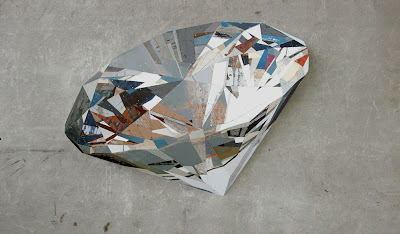 |
| Flawless, 2007 |
Ron van der Ende: I started restricting myself to old wood as material for my sculptures in 1996 because it boasts a wealth of color and texture, it is readily available and inexpensive, and because it is inherently 'imperfect'. Sometimes it looks like it has been touched a million times. It feels good to make something of value from such a modest material.
 |
| Axonometric Array, 2008 (studio) |
RvdE: I vividly remember having my 'eureka!' moment. It suddenly dropped into my head that I could work in this material almost flat to produce a large and light sculpture. I realized instantaneously that it could be done, that it would be possible to do cars and limitless other subjects. That I would not need any detailed technical drawings but just one photograph. And that the result would be unique and spectacular and sell like hot cakes.
 |
| Fly Over, 2002 (studio) |
RvdE: It felt then (and it feels now) like I have stumbled upon a continent of possibilities that is mine alone to explore. And twelve years on, there is still so much opportunity to develop and grow.
 |
| Vostok, 2006 |
 |
| Shipsection, 2003 (artist in studio) & Bathyscaphe Trieste, 2010 |
RvdE: Most of my material I find in the streets. I find it myself or my
friends call to report a dumpster/skip with interesting materials.
JR: Have your material sources changed over the years?
RvdE: It has shifted a little bit to buying materials at specialized stores
because not as many material is being thrown away as a couple of years
ago. People are making their own fake Piet Hein Eek furniture with it.
Sometimes I buy stuff from the internet, like in 2008 I bought a lot of
two hundred and fifty antique doors. That makes a full truckload!
JR: Have you developed relationships by collecting scraps from practical woodworkers or other artists?
RvdE: Not really. The scraps have to be old you know.
JR: I know some old woodworkers here in Asheville. Maybe I will send you a few of their scraps.
RvdE: YEAH!
 |
| Plymouth Custom Suburban 1969, 2000; G.A.Z.21 Volga 1962, 2000; Capri, 2002 |
RvdE: Mostly I'm dealing with sculptural qualities. I do not want aesthetics or style to be dominant in my work. And there is a conceptual side but not as 'words intended to justify the work', more as a strategy for possible associations. This becomes especially interesting when pieces are made in a deliberate combination. I used to work in themed series in the past. Series of cars for example, a set about polar exploration or space flight. But in recent years I've started trying on seemingly illogical combinations to great effect. In the end though, every single piece will have to be strong enough to survive in the world individually.
 |
| DS II (Pallas), 2008 & Phoenix: Rise ! (Pontiac Firebird Trans-Am), 2011 (studio) |
 |
| Still Life & On Re-entry (Burning Log), 2010 |
RvdE: I have not had these pieces together in a show, unfortunately. Mostly my work sells on the first exhibition they are shown in, so not much opportunity to make combinations like that. It's a shame in this case. Both these pieces have a life and death angle that would have made for a nice combination.
JR: Do you have any details or construction shots from those two endeavors?
 |
| On Re-Entry (Burning Log), 2010 (construction, details, studio) |
 |
| Still Life, 2010 (details via Happy Famous Artists Collective) |
JR: You showed "Perishables" at the Armory in NYC in 2011 and, sadly, we missed it. Do you have any upcoming shows in the US?
RvdE: I'll have a solo show in the spring of 2013 with Ambach & Rice Gallery in Los Angeles.
 |
| 727, 2008 & KO Valkyrie, 2010 |
JR: I would also like to include this video if you are happy with it:
RvdE: Sure. It's in Dutch though... I would translate but I'm terribly busy right now. At one point I tell the cameraman that I am sawing "a very tricky little piece of wood."
JR: Thank you very much for speaking with me and my community. It was a pleasure to get to know your work.
RvdE: Of course. Let me know if you have any more questions.Best,
Ron van der Ende
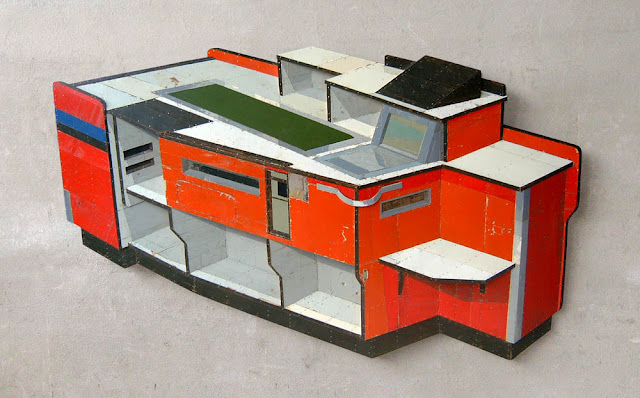 |
| Checkout 2 / Kassa 2, 2005
(June's featured artist is North Carolina's own Bob Trotman. If you have questions for Bob, please leave them here,
in the comments)
|
Labels:
art feature,
bas-relief,
discarded wood,
Dutch,
interview,
Netherlands,
reclaim,
reclaimed,
repurposed,
Ron van der Ende,
Rotterdam,
scrap,
sculpture,
table saw,
upcycled,
woodpile,
woodworker with power tools
Location:
Rotterdam, The Netherlands
2012/04/29
A Promise Is a Promise: Where's My Update?!
Top two reasons it has taken so long to deliver: a yard sale and a stolen bike. But I don't want to talk about that.
So there it is, the corner bookshelf, nestled in the chaos of Hip thrift. I do believe it will be more comfortable once it has been claimed by a new owner. Keep in mind, it won't look like this anywhere else; the concept is a blank slate.
The open design makes it ideal for the creative display of toys, books, objects and art.
Meanwhile, I have been doing a bit of painting.
Here are new chairs to go with the tree table. Three are pictured from the set of four.
On a warm March morning, I went to a secret location with the artist Penish Wrinkle and we snagged some wonderful graffitied* tool cabinet doors.
*Graffitied is not a word yet! But I believe that one day it will be.
This is the backside of the door, which is being repurposed as the backing for a crooked, wobbly bookcase that I picked up at an estate sale.
And now it is solid as a rock and no longer crooked. I wire brushed the loose paint and heavily glazed the entire door, front and back, so it is a safe piece despite its delinquent origins.
The bookcase for vinyl sold yesterday and two different parties are now very interested in the tree table. It feels great to be productive! Thanks to everyone for your support.
___
] j [
So there it is, the corner bookshelf, nestled in the chaos of Hip thrift. I do believe it will be more comfortable once it has been claimed by a new owner. Keep in mind, it won't look like this anywhere else; the concept is a blank slate.
The open design makes it ideal for the creative display of toys, books, objects and art.
Meanwhile, I have been doing a bit of painting.
Dry brushwork on the side of a bookcase.
Here are new chairs to go with the tree table. Three are pictured from the set of four.
On a warm March morning, I went to a secret location with the artist Penish Wrinkle and we snagged some wonderful graffitied* tool cabinet doors.
*Graffitied is not a word yet! But I believe that one day it will be.
This is the backside of the door, which is being repurposed as the backing for a crooked, wobbly bookcase that I picked up at an estate sale.
And now it is solid as a rock and no longer crooked. I wire brushed the loose paint and heavily glazed the entire door, front and back, so it is a safe piece despite its delinquent origins.
The bookcase for vinyl sold yesterday and two different parties are now very interested in the tree table. It feels great to be productive! Thanks to everyone for your support.
___
] j [
Labels:
bookcase,
bookshelf,
clear coat,
distressed,
glaze,
great news,
Hip Thrift,
no cuts,
no cutting,
painting outdoors,
Penish Wrinkle,
planks,
reclaim,
reclaimed,
refurbished,
repurposed,
sold,
upcycled,
West Asheville
Location:
201 Haywood Rd, Asheville, NC 28806, USA
2012/04/20
Corner Bookcase is here
After using the six odd boards from the reclaimed futon frame for my personal experiment, it's time to move on to the production piece.
Each of the twelve remaining boards measures 51-3/8 x 2-1/2 x 3/4 (inches).
Two similar panels are constructed as above, and interlocked below.
The back half of each shelf is then attached.
This detail shows how the two pieces of the frame interlock.
The connection is made with dowels so that the case can be split apart and transported.
If you give the objects enough space, as above, there will also be room to hang small art pieces within and around the two frames. I will move the Corner Bookcase into Hip Thrift tomorrow, so look for the update.
] j [
Labels:
bookcase,
bookshelf,
budget,
deconstructed futon frame,
discarded wood,
doweled,
fast cheap and easy,
Hip Thrift,
no cuts,
no cutting,
prototype,
reclaim,
reclaimed,
shelf stock,
three-point base,
upcycled
Location:
Asheville, NC, USA
2012/04/19
A Very Lightweight Bookcase: Rough Design
Against the near wall in my workshop are 18 boards reclaimed years ago in Brooklyn from a broken futon frame. It sure did take a long time for this bastard wood to tell me what it wanted to be: a complete departure from my previous pair of bookcases.
Using only the four short and two long boards, I set myself to the task of making an experimental bookcase for my own use.
This model is low and long and close to the ground, well suited to my "Spartan living style" (as described by motorcycle fabricator Norm Plombe).
The shelves are rather narrow and bouncy, and the bottom "shelf" is the floor itself. These factors make the prototype unsuitable for mainstream consumption, but perfect for my meager needs and open spaces.
Using the remaining twelve regular boards, the upcoming shelf will more than double the weight of my experiment. It will also measure twice as tall and nearly twice as long, gaining stability by wrapping completely around the corner. After framing it I will decide on the use of backing, which would bring another material element into play. I hope instead that my design can allow the bookcase to fit snugly against the wall.
] j [
Using only the four short and two long boards, I set myself to the task of making an experimental bookcase for my own use.
This model is low and long and close to the ground, well suited to my "Spartan living style" (as described by motorcycle fabricator Norm Plombe).
The shelves are rather narrow and bouncy, and the bottom "shelf" is the floor itself. These factors make the prototype unsuitable for mainstream consumption, but perfect for my meager needs and open spaces.
Using the remaining twelve regular boards, the upcoming shelf will more than double the weight of my experiment. It will also measure twice as tall and nearly twice as long, gaining stability by wrapping completely around the corner. After framing it I will decide on the use of backing, which would bring another material element into play. I hope instead that my design can allow the bookcase to fit snugly against the wall.
] j [
Labels:
ages ago,
backing,
bookcase,
bookshelf,
budget,
deconstructed futon frame,
discarded wood,
DIY,
no cuts,
no cutting,
planks,
prototype,
reclaim,
reclaimed,
shelf stock,
three-point base,
upcycled
Location:
Asheville, NC, USA
2012/04/11
A Tale of Two Woodpiles {and the Hip Horse}
Last week, someone finally brought down the axe on an old rotting tree in their front yard. And I swept in to pick up the pieces. Pun intended; it's one of those days.
This is a weird crystallized dead grub.
And this grub was quite alive. Which brings me to a burning question: how can I be sure that this beautifully eroded wood is ready to work once it has been seasoned? I thought of cutting it into small enough pieces and cooking out the critters in my home oven. I also thought of bartering with a local reclaim outfit to use their kiln in exchange for the lion's share of the wood. Has anyone tried to do this on their own? Please leave comments!
The larger pieces have decayed to just the right state to produce interesting burls, so I am very eager to start seasoning it. I even wonder if some aggressive chainsaw slicing might be good enough for removing all of the little buggers . . .
Now the coolest part of this story is how I met the creator of the Bottitudes. It's her tree in her yard. I always get permission before scrapping, so when we got to talking Susan shared her creations. Look for these funky little raku-glazed bots soon at Hip Thrift.
My son is with me on Spring Break and the next story got him all excited. I have been scoping out construction jobs and scrap piles and finally corralled the boss on this one down on Waynesville Ave.
The foreman is more than happy to let me raid the scrap pile for the duration of construction.
And my son is more than happy to get down to it and load some scrap! Call it shameless child labor if you'd like, but does get paid . . . in root beer floats . . .
Whether it be dead trees or seemingly useless piles of scrap, we are on the lookout for wood. I will be sure to put it to good use!
] j [
Labels:
Bottitudes,
chainsaw,
dead wood,
discarded wood,
family,
grub,
Hip Thrift,
insects,
kiln,
Plymouth Voyager,
reclaim,
root beer floats,
rotted tree,
scrap,
vigilant,
West Asheville,
what you had,
woodpile,
workhorse
Location:
West Asheville, Asheville, NC 28806, USA
Subscribe to:
Posts (Atom)




